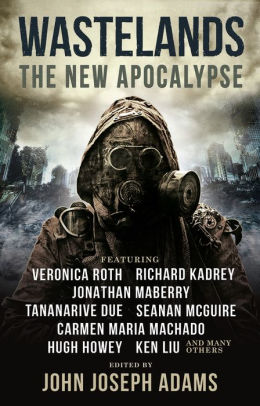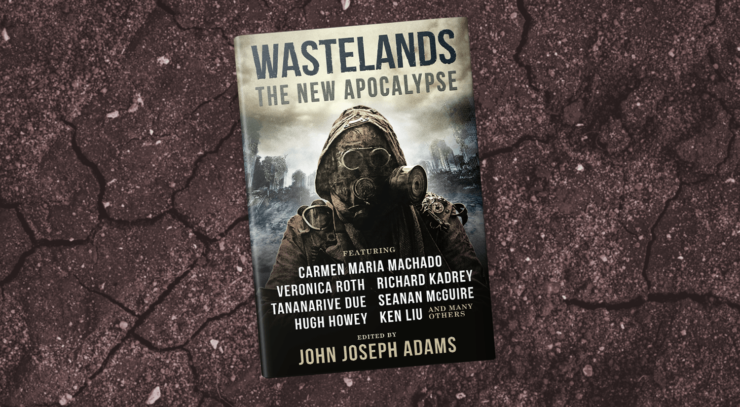Wastelands: The New Apocalypse is the third volume in John Joseph Adams’ curated series of apocalyptic and post-apocalyptic short stories. With this edition, the series now collects over 80 different stories of cataclysm, disaster, and general tribulation.
The New Apocalypse differs slightly from its predecessors, in that it includes original stories as well as carefully selected reprints. With over 30 stories included, there’s no perfect way to draw conclusions about the anthology—however, there are some clear patterns that emerge across the book.
First, a simple demographic note. Wastelands: The New Apocalypse is an American perspective on the apocalypse, with only a very few contributors coming from outside of the United States. There are, for example, nine contributors from California, compared to one from all of Europe. Or, amusingly, as many contributors from Kansas as from, say, the entire Southern Hemisphere. This is a book as quintessentially American as A People’s Future of the United States, if slightly less overt about it in the titling.
Second, the stories in The New Apocalypse, on the whole, take a very literal view of the apocalypse. Whether that’s zombies or viruses or comets or fungus (there are a few fungi stories in here!), we are wiped out. This is not an anthology of metaphorical, psychological, or internalised apocalypsi. There’s plenty of action contained in this volume, and not a lot of metaphor.
Third, and finally, this is a rough generalisation, but there’s a familiar, recurring structure that emerges across the book. A literal apocalypse is happening/has happened, it is detailed (the extent to which is dependent on the Hard SF and/or infodumping proclivities of the writer), and then we follow one of the survivors on their journey of self-actualisation.
As a result, the most successful efforts in The New Apocalypse are those that create a strong emotional connection with the protagonist—so that the character’s journey to fulfilment feels like something the reader can share in, rather than merely witness. Meg Elison’s “Come On Down” is a strangely heartwarming story about recreating daytime TV in a post-apocalyptic setting—a tale of tiny kindnesses. Hugh Howey’s “Bones of Gossamer” features an everyman character, who pulls the reader into a story not only about culture clash and tradition, but also dedication and love. Shaenon K. Garrity’s “Francisca Montoya’s Almanac of Things That Can Kill You” is gently abstracted, rewarding close readers with real emotional impact, buried in its gazetteer format. Violet Allen’s “A Series of Images from a Ruined City at the End of the World” also experiments with the narrative format: a story that shows how even the most toxic, nightmarish future can hold moments of beauty.
“And the Rest of Us Wait” is a standout story from one of The New Apocalypse’s international contributors, Corinne Duyvis. Iveta and her family are trapped in an underground bunker in the Netherlands—alongside the billions of other people who weren’t deemed special enough to be saved from the imminent disaster. Iveta, her family, and her peers are all struggling with gritty, everyday, unsolvable problems. There are, cleverly enough, some traditionally ‘heroic’ figures in the background, but they are deliberately positioned as red herrings: this is a story about the rest of us. Iveta makes it through each day, gets entangled in petty politics, and participates in minor acts of rebellion. She doesn’t save the world—or even ‘find herself’ in a particularly glamorous sense. She endures. It is not the most action-packed of the entries (Jeremiah Tolbert’s goofily Mad Max-ian “Four Kittens” takes the cake there), nor the most triumphant—or even emotional satisfying. It is an oddly realistic, beautifully-composed story that tries to frame the apocalypse not as an individual’s ‘time to shine’, but as a collective struggle. The apocalypse not as a platform for an individual’s Hero’s Journey, but as an implacable challenge for ‘the rest of us’.
Buy the Book


Wastelands: The New Apocalypse
It is hard not to see the three dominant trends in The New Apocalypse—the Americanness, the literalness, and the individual self-actualisation—as interlinked; with a story like “And the Rest of Us Wait” the exception that proves the rule.
Globally, we are obsessed with the apocalypse: a global Reuters poll found that one in seven people believed the world would end during their lifetime. But America takes this to another level: this number increases to one in four in the United States.
Betsy Hartmann, author of The America Syndrome: Apocalypse, War and Our Call to Greatness, talks about a national compulsion to cast ourselves as, as this review summarises it, ‘the chief actors in times of crisis’. Hartmann posits that this cultural urge stems back to the Puritans, and an underpinning belief that “Americans are special and exceptional, a chosen people”. This Salon examination of apocalyptic culture goes a step further, and talks about a genuine eagerness for the apocalypse within certain audiences: a lusty wish for the End Times and desolation. This is an extreme interpretation, but helps demonstrate the underpinning belief. The apocalypse might be really, really bad, but it also a time to shine—your moment to step up, become the hero that you were always meant to be.
Wastelands: The New Apocalypse provides a hefty buffet of the contemporary American apocalyptic story, each one—again, broadly—about people finding themselves at the end of the world. A heartless soldier finds his humanity. A thuggish goon finds his heart. A shy comedian finds her voice. A scared young woman finds the strength to stand up for herself. A conflicted playwright finds her buried talent. Stories of people that, in a time of adversity, tap into previously untapped stores of courage, cunning, and self-esteem. People who have lost everything, but finally found their purpose.
The result is a collection that’s oddly optimistic: not a word that one normally associates with a collection of stories about mass destruction. As long as we can identify more with the lead character than the faceless hordes of the dead, these stories are, well, positive. The more mechanical ones serve as theoretical survival guides; the more emotional ones provide reassurance. Whatever happens, these stories whisper: you’ll be ok. Given the chaos and unease of everyday life in the real world, that’s no bad thing. These stories are entertaining and action-packed; clever, creative, and sometimes even a little bit funny. It may be ironic to use the worst disasters we can imagine as a platform for escapism, but, as the Wastelands series shows, the apocalypse is one hell of an opportunity.
Wastelands: The New Apocalypse is available from Titan Books.
Jared Shurin is the editor of The Djinn Falls in Love, The Outcast Hours, The Best of British Fantasy, and many other published and/or forthcoming works. He writes irregularly at raptorvelocity.com and continuously at @straycarnivore.










